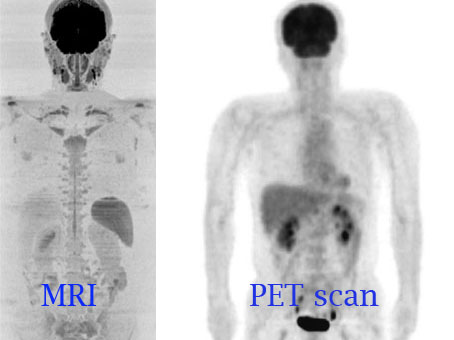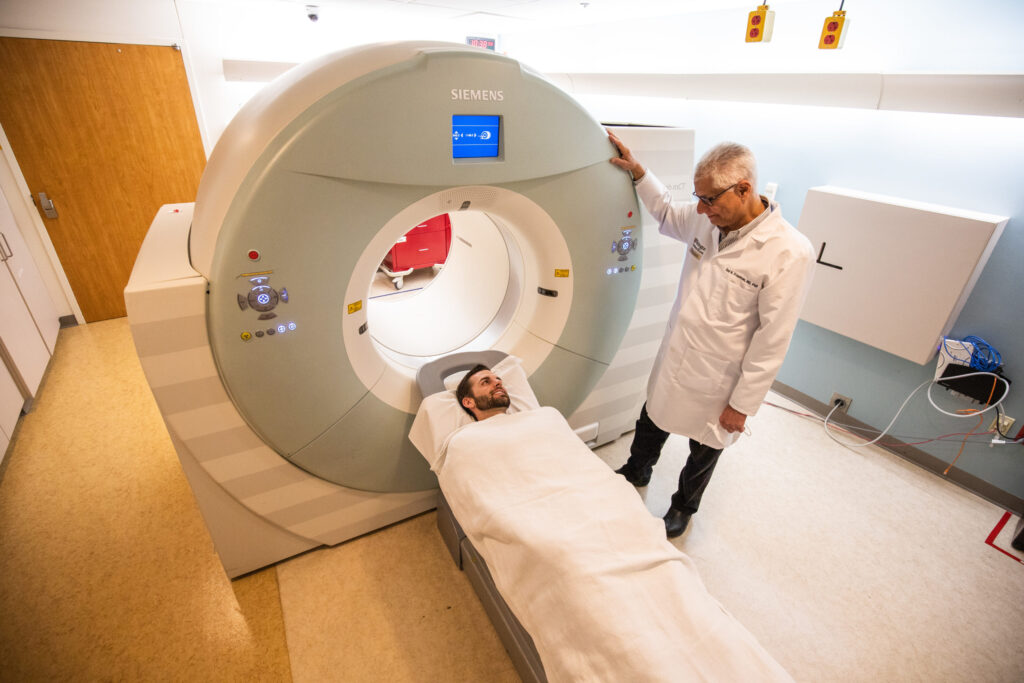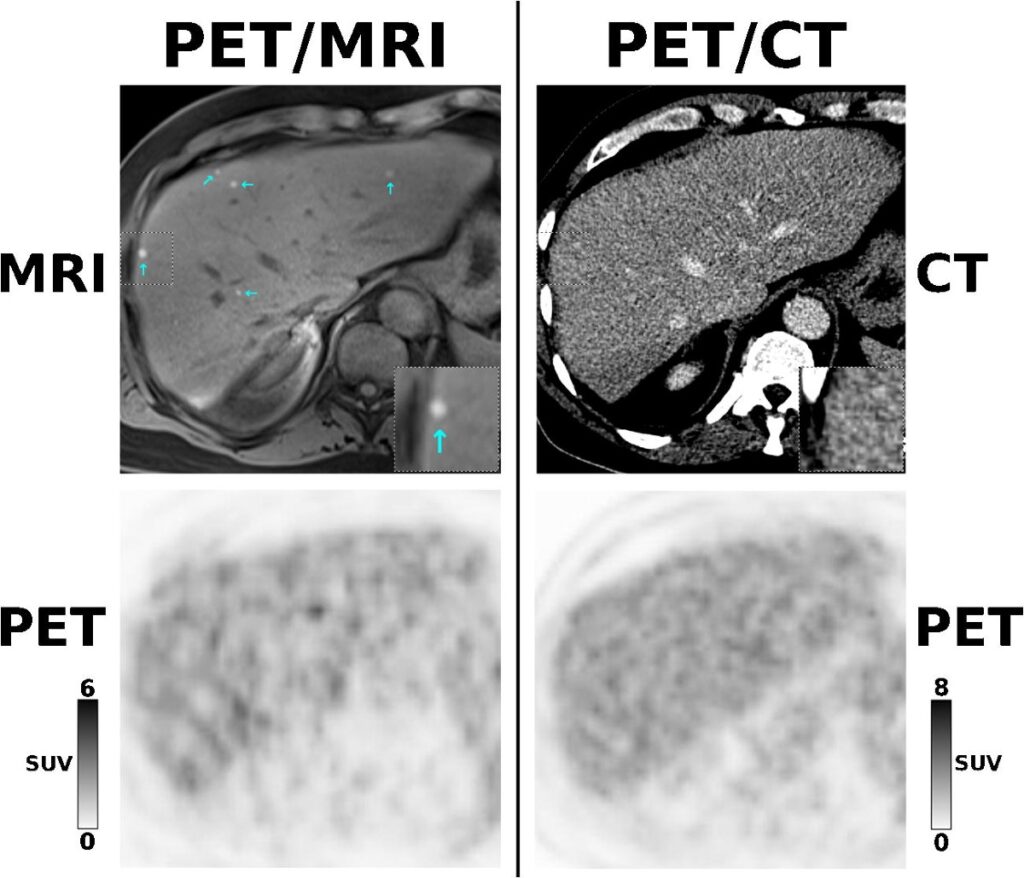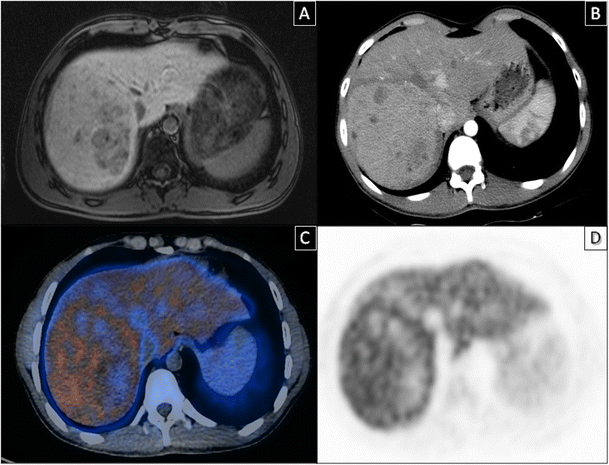When your doctor recommends an imaging test, understanding the differences between a PET scan and an MRI can help ease your concerns.

These powerful diagnostic tools serve different purposes and work in completely different ways. Let’s break down everything you need to know about these important medical tests.
What Is a PET Scan?
PET (Positron Emission Tomography) scans show how your tissues and organs are functioning. Unlike other imaging tests that primarily show structure, a PET scan reveals activity at the cellular level by tracking a radioactive sugar solution injected into your bloodstream.
Think of it as watching a factory in operation rather than just looking at the building itself. PET scans excel at detecting areas of unusual metabolic activity, particularly useful for spotting cancer cells, which typically consume sugar at a higher rate than normal cells.
What Is an MRI?
MRI (Magnetic Resonance Imaging) uses powerful magnets and radio waves to create detailed images of the structures inside your body. No radiation is involved. Instead, the magnetic field temporarily realigns water molecules in your tissues, and the radio waves cause these aligned atoms to produce signals that create cross-sectional images.
An MRI provides exceptional detail of soft tissues, making it ideal for examining your brain, spinal cord, nerves, muscles, ligaments, and tendons.
PET Scan VS MRI
| Feature | PET Scan | MRI |
| What it measures | Metabolic activity/function | Anatomical structure/tissue characteristics |
| How it works | Tracks radioactive sugar in the body | Uses magnetic fields and radio waves |
| Radiation exposure | Yes (small amount) | None |
| Typical scan time | 30-60 minutes | 15-90 minutes |
| Noise level | Quiet | Very loud (requires ear protection) |
| Confined space | Partially enclosed | Fully enclosed tube (unless open MRI) |
| Preparation required | Fasting for 4-6 hours | Usually none (unless contrast is used) |
| Typical cost range | $3,000-$6,000 | $1,200-$4,000 |
| Insurance coverage | Often limited to specific conditions | Generally well-covered |
| Contrast agent used | Radioactive tracer | Gadolinium (only for some scans) |
| Claustrophobia concerns | Moderate | High (unless open MRI) |
| Availability | Specialized centers only | Widely available |
When Is a PET Scan Used?
Cancer Diagnosis and Treatment
PET scans excel at:
- Detecting cancer spread (metastasis)
- Determining if a suspicious area is malignant or benign
- Checking if cancer treatment is working
- Finding recurrences in patients with previous cancers
Brain Disorders
PET scans help doctors visualize:
- Areas affected by dementia (including Alzheimer’s disease)
- Seizure-triggering regions in the brain
- Brain tumor activity versus post-treatment scarring
Heart Health
Cardiologists use PET scans to:
- Assess blood flow to the heart muscle
- Identify damaged but still viable heart tissue
- Evaluate the effectiveness of cardiac treatments
When Is an MRI Used?
Neurological Conditions
MRIs provide detailed images of:
- Brain tumors, strokes, and aneurysms
- Multiple sclerosis plaques
- Spinal cord injuries and abnormalities
- Causes of headaches or seizures
Musculoskeletal Problems
Orthopedic specialists rely on MRIs for:
- Torn ligaments, tendons, and cartilage
- Joint damage and inflammation
- Disk problems in the spine
- Bone infections

Organ and Tissue Assessment
MRIs help evaluate:
- Liver, kidney, and other organ abnormalities
- Uterine fibroids and ovarian cysts
- Prostate conditions
- Breast cancer (as a complement to mammography)
Side Effects and Risks
PET Scan Side Effects
- Radiation exposure: Although minimal, there is some radiation exposure (about the equivalent of a few months of natural background radiation)
- Allergic reactions: Rare but possible reactions to the radioactive tracer
- Blood sugar concerns: Diabetic patients need special preparation
- Post-scan precautions: You may be advised to limit close contact with pregnant women or young children for a few hours
MRI Side Effects
- No radiation: MRIs don’t use radiation, eliminating that risk
- Magnetic concerns: Metal objects can be dangerous in the MRI environment
- Contrast reactions: Some people experience allergic reactions to gadolinium contrast
- Heat sensation: Rarely, patients report feeling warmth in the scanned area
- Claustrophobia: The enclosed space can cause anxiety
- Noise effects: The loud banging can cause temporary discomfort or hearing issues if proper ear protection isn’t used
Preparing for Your Scan
PET Scan Preparation
- Fast for 4-6 hours before your appointment (water is usually permitted)
- Avoid strenuous exercise for 24-48 hours beforehand
- Check medication instructions with your doctor (some may affect results)
- Dress warmly as the scanning room is typically kept cool
- Remove all metal objects including jewelry and watches
- Arrive early for radiotracer injection (usually 1 hour before scanning begins)
- Arrange transportation home as driving immediately after isn’t recommended
MRI Preparation
- Complete screening questionnaire about metal implants or devices
- Remove all metal items including jewelry, watches, and clothing with metal fasteners
- Consider anti-anxiety medication if you’re claustrophobic (must be prescribed in advance)
- Wear comfortable, loose clothing without metal elements
- Follow any contrast dye instructions if your scan requires it
- Empty your bladder before the procedure for comfort
- Bring earplugs or use provided ones to dampen the noise

Which Is Better: PET or MRI?
Neither is universally “better” – they serve different purposes. Think of them as different tools in a toolbox; you wouldn’t use a hammer when you need a screwdriver.
PET scans are superior for:
- Detecting early-stage cancers before structural changes appear
- Determining if tissue is actively cancerous versus scar tissue
- Evaluating metabolic activity in the brain for certain neurological conditions
- Determining cancer treatment effectiveness quickly
MRIs excel at:
- Detailed soft tissue imaging (tendons, ligaments, brain tissue, spinal cord)
- Detecting small structural abnormalities
- Providing comprehensive joint assessments
- Evaluating complex neurological conditions
Sometimes, combined PET-MRI machines offer the benefits of both technologies in a single scan session.
Cost and Insurance Considerations
PET scans typically cost more than MRIs and often have stricter insurance approval requirements. Insurance companies usually require:
- Prior authorization
- Documentation of medical necessity
- Appropriate diagnosis codes
- Exhaustion of less expensive diagnostic options

Most insurance providers more readily approve MRIs for a wider range of conditions, though still with certain restrictions.
Always check with your insurance and get pre-authorization when possible.
Frequently Asked Questions
Can I eat before my imaging test?
For MRIs, you can usually eat normally unless otherwise instructed. For PET scans, you’ll need to fast for 4-6 hours beforehand.
Which test is better for cancer detection?
PET scans are often superior for initial cancer detection and monitoring treatment response, while MRIs provide detailed anatomical information about tumor size and location.
Will I feel anything during these scans?
Neither scan is painful. During a PET scan, you might feel a cool sensation when the radiotracer is injected. During an MRI, you’ll feel nothing but will hear loud knocking noises.
How long do I have to stay still?
Both tests require you to remain still during scanning sequences. MRIs typically require stillness for 15-20 minutes at a time, while PET scans require about 30 minutes of continuous stillness.
What happens if I’m claustrophobic?
For severe claustrophobia:
- Ask about open MRI options
- Discuss sedation possibilities with your doctor
- Consider a PET scan which is less confining than a traditional MRI
- Request anti-anxiety medication before your appointment
Can I have these scans if I’m pregnant?
Generally, both scans are avoided during pregnancy unless absolutely necessary. If required, MRI is preferred over PET during pregnancy due to the lack of radiation.
How soon will I get results?
Most facilities provide results within 24-48 hours to your referring physician, though some take up to a week for complex cases.
When Both Tests Might Be Needed?
In some complex medical situations, your doctor might order both a PET scan and an MRI:
- Brain tumors: An MRI shows the tumor’s size and location, while a PET scan reveals whether it’s actively growing
- Cancer staging: MRI provides detailed anatomical information while PET shows where cancer cells are metabolically active
- Treatment planning: Both tests together give complementary information for surgical or radiation planning
- Neurological disorders: Combined information provides both structural and functional brain assessment
Final Thoughts
Understanding the differences between PET scans and MRIs can help you better participate in your healthcare decisions. These powerful imaging tools have revolutionized medical diagnosis, allowing doctors to identify problems earlier and with greater precision than ever before.
If your doctor has recommended either test, don’t hesitate to ask questions about why that particular scan was chosen for your condition. Remember that while these tests can seem intimidating, they’re painless diagnostic tools that provide crucial information for your treatment plan.
The most important thing is getting the right test for your specific medical needs, which your healthcare provider is best positioned to determine.
